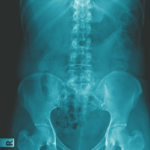Maksymowych et al. assessed the frequency of axial spondyloarthritis (axSpA) according to extra-articular presentation and human leukocyte antigen B27 (HLA-B27) status and sought to identify features that distinguish patients with axSpA from those with non-specific back pain. Their data support recommendations that patients with chronic back pain and extra-articular features related to axSpA be screened for axSpA with MRI and referred to a rheumatologist.

Measures of Success
Can a treat-to-target strategy achieve better outcomes for patients with spondyloarthritis? Insights from the latest data.

Anti-Infliximab Antibodies Predict Response in Axial Spondyloarthritis
Pimentel et al. evaluated the influence of anti-infliximab antibodies on patients with axial spondyloarthritis. The researchers found that anti-infliximab antibodies were associated with decreased infliximab performance and difficulty tapering its dosage, as well as a good clinical response to a second, alternate tumor necrosis factor inhibitor.

New Indications Possible for Bimekizumab-bkzx
The FDA has accepted applications for three new indications for bimekizumab-bkzx, a humanized interleukin (IL) 17A and IL-17F antagonist: psoriatic arthritis, non-radiographic axial spondyloarthritis and ankylosing spondylitis.

More Than Meets the Eye
SAN DIEGO—In recent years, the recognition of nr-axSpa has helped identify the cause of back pain in many patients previously without a diagnosis. However, questions remain about how to avoid under- or over-diagnosing the condition. In the session titled, Pearls and Pitfalls in Diagnosing Non-Radiographic Axial Spondyloarthritis, several speakers provided high-yield insights on this topic. Diagnostic challenges, imaging options and mimics to watch for were among the specific points of discussion.

Non-Radiographic Axial Spondyloarthritis: A Review
SAN DIEGO—Alexis Ogdie-Beatty, MD, MSCE, associate professor of medicine, associate professor of epidemiology, Department of Medicine, Hospital of the University of Pennsylvania, Philadelphia, gave a presentation on non-radiographic axial spondyloarthritis (nr-axSpA) in the Review Course prior to ACR Convergence 2023.

Concerning the Back: Updates in AS & nr-axSpA
During the 19th Annual Johns Hopkins Advances in the Diagnosis and Treatment of the Rheumatic Diseases Symposium, Dr. Atul Deodhar provided an overview on axial spondyloarthritis (axSpA) and non-radiographic axSpA, with helpful insights into the diagnosis and care of patients with these conditions.

Do NSAIDs Mask MRI Findings in Patients with Axial Spondyloarthritis?
Research suggests the use of non-steroidal anti-inflammatory drugs may mask the amount of sacroiliac joint inflammation found on MRI in patients with axial spondyloarthritis.

Treat to Target in axSpA
PHILADELPHIA—Treat to target (T2T) is a common phrase in rheumatology these days—and a welcome one.1 Many of us are familiar with what T2T means in rheumatoid arthritis (RA), but we may be less sure of its meaning in axial spondyloarthritis (axSpA). At ACR Convergence 2022, Alexis Ogdie, MD, associate professor of medicine and epidemiology, University of…

Top Research in Axial Spondyloarthritis Presented at ACR Convergence 2022
PHILADELPHIA—Approximately 100 research abstracts on axial spondyloarthritis (axSpA) were accepted for presentation at ACR Convergence 2022. It is exciting to see a wealth of research on axSpA being undertaken worldwide. Here, we highlight important points from 10 of these studies. 1. Abstract 0378: Prevalence of Axial Spondyloarthritis (axSpA) in Patients Treated for Chronic Back Pain…